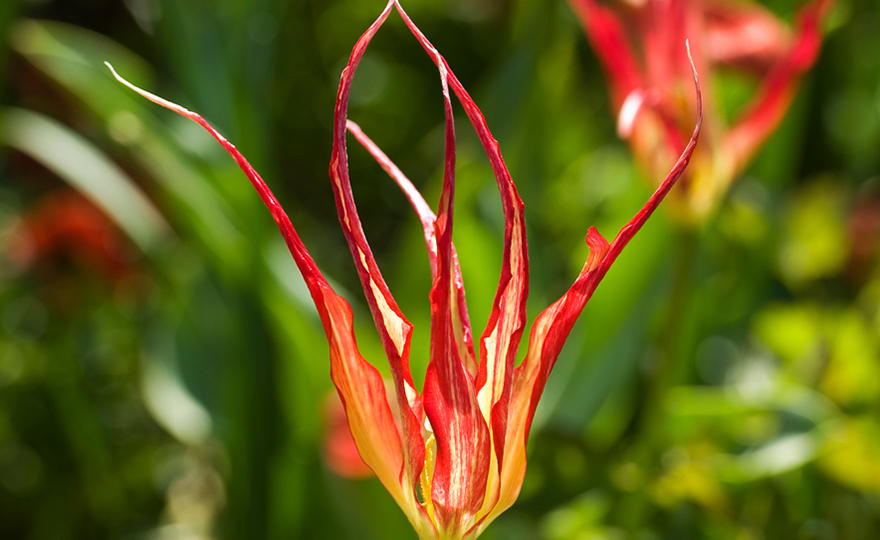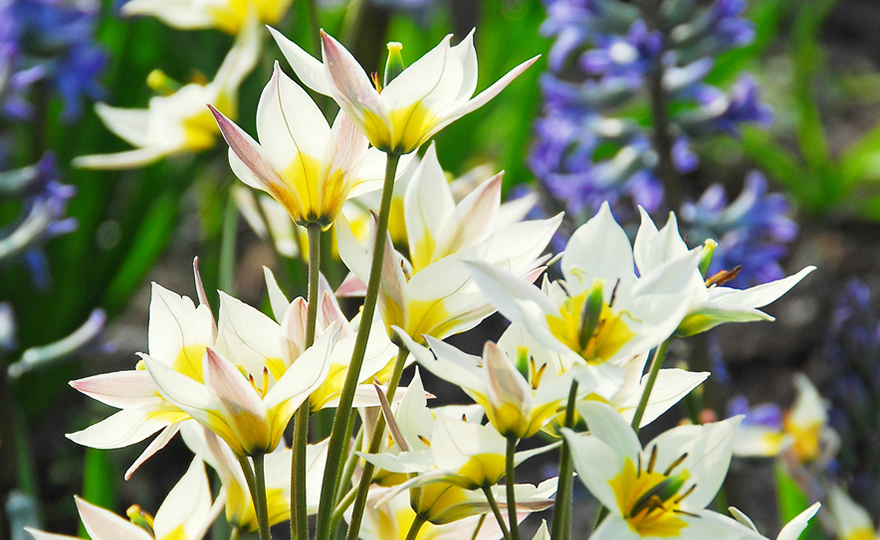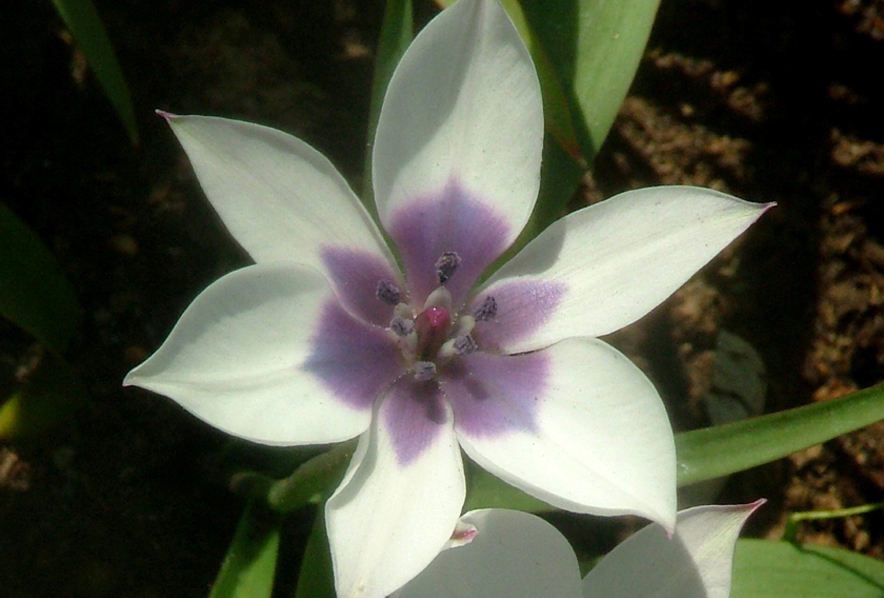The Ancient Miracle Tulips-Genuinely Critter Resistant
SPECIES TULIP – T. ACUMINATA, THE FIRE FLAME TIP
The Ancient Miracle Tulips-
Genuinely Critter Resistant
This year Harvesting History’s fall newsletter series is going to focus on spring flowering bulbs that are critter resistant and great plants for nourishing pollinators. In the last three newsletters, we discussed Rock Garden Irises (Iris reticulatas), Chionodoxas (Glory of the Snow), Galanthus (Snowdrops) and Hyacinthoides (Bluebells). In this newsletter we are going to begin to focus on the Species Tulips. We will discuss Species Tulips for the next 3 newsletters.
I am about to describe for you 4 species tulips that I will tell you deer don’t eat, BUT all of you need to know that when deer are stressed enough, they will eat anything and everything. This includes thorny holly leaves, cactus and the lovely tulips I am about to describe. In my garden, where there are plenty of deer every day, these tulips are not touched, but even I know that at some future date they may be consumed.
For those of us in 21stcentury America, the species tulips are a wonder. These are the original wild tulips collected from Persia, the Caucasus, Africa, Southern Europe, etc. Even today, wild species are still being discovered and cultivated for commercial sale. Understand, that after these wild species are collected and nurtured through professional cultivation, they often change dramatically. They can become taller, their blossoms can become larger, and their colors may be more vivid. That is OK, because even if you found them in the wild and brought them to your own gardens, these changes would take place. Loving care does that to most wild things.
The greatest feature about the species tulips is that for some reason, unknown to mankind, the deer are not interested in eating them and the moles and voles seem to leave them alone as well.
Years ago when species tulips became available to the public, they were not very popular because they were very short (4-6 inches) with very delicate colors (pink, white, yellow). Because of their critter resistant qualities, interest has grown dramatically in species tulips and larger, more vividly colored species tulips have been collected from the wild and cultivated. Today, there are some taller, very dramatic species tulips available to the public. Beginning with this newsletter we will describe some of the best species tulips available today.

SPECIES TULIP – T. ACUMINATA, THE FIRE FLAME TIP
This ancient tulip was collected sometime during the 1500s and introduced to the European and British public in the 1800s. It was also known as The Fire Flame and The Turkish Tulip. It is not often offered to the public.
This tulip is very tall for a Species Tulip, often reaching a height of 14-16 inches, but the truly extraordinary aspect of this tulip is its uniquely narrow, long, gracefully curving, yellow petals that are trimmed in scarlet. The visual impact is substantial and memorable.
Anna Pavord in her treatise on tulips titled, The Tulip,provides this historical description:
“This was one of several newly introduced species that the Rev. Henry
Harpur Crewe had growing in his garden at Drayton Beauchamp Rectory,
Tring, Herts, where he was Rector from 1860-1883. Writing in The Garden
on 20 May 1876 he described T. acuminata as ‘so quaint and curious that
no one who has once grown it likes to be without it.’”
Acuminata shows best when planted in drifts of at least 10 bulbs. Bulbs should be planted 6 inches deep and 3-4 inches apart.
 SPECIES TULIP – TULIPA TURKESTANICA
SPECIES TULIP – TULIPA TURKESTANICA
Turkestanica is native to Central Asia, specifically the Tien Shan and the Pamir-Alai and the Dzungaria region of Northwest China. It grows on rocky slopes, by streams and the harsh stony ledges at altitudes of 5000-7500 feet. It is a very vigorous and very hardy little tulip. It was introduced into Europe around 1875.
You grow Turkestanica as a spring ground cover or border plant because each stem produces multiple flowers – as many as 7 per stem. The flowers are small with pointed cream petals that fade into a subtle yellow at the base of the blossom. In full bloom the flowers resemble small stars strewn across a blanket of green leaves. This is one of those wonderful plants that you can plant and then forget about it.
The plant reaches a height of 8-10 inches and is hardy from Hardiness Zones 4-8. It is best planted in drifts of 5-10 bulbs or more. The bulbs should be planted 5-6 inches deep and 4-6 inches apart. It multiplies rapidly, doubling in number of bulbs yearly.
 SPECIES TULIP – TULIPA HUMILIS VIOLACEA
SPECIES TULIP – TULIPA HUMILIS VIOLACEA
Humilis Violacea is a must have! They don’t create tulips any smaller than this one (3-5 inches at most), but few flowers have the intensity of color that this little sprite has. Anna Pavord in her marvelous book, BULB, describes the blossom so exquisitely when she writes,
“From a narrow, funnel-like base, the flower opens into a goblet of rich rosy-mauve”
Yes, that is exactly what happens, but it is hard to appreciate unless you are staring at a carpet of these flowers. They should be planted in drifts of no less than 25 bulbs. They also make lovely container plants because of their short height and intense color.
Violacea is as rugged as they come. The plant is native to Northern Iran and Iraq and south and eastern Turkey where it grows on the rocky slopes at elevations of 10,000-12,000 feet. There, in the harshest of climates, it produces breathtaking beauty. The plant was introduced in Europe around 1860 and became known as the Red Crocus Tulip because it bloomed at the same time as the crocus and was similar in size.
The plant reaches a height of 3-5 inches and is hardy from Hardiness Zones 3-8. The bulbs should be planted 5-6 inches deep and 2-3 inches apart. It multiplies rapidly, doubling in number of bulbs yearly.
 SPECIES TULIP – SYLVESTRIS IN BUD
SPECIES TULIP – SYLVESTRIS IN BUD
Some plants you grow for their stunning beauty, some for their unforgettable fragrance, some because they are just weird, but once in a while you grow a plant because it is so darn entertaining. Because it is so darn entertaining, and pretty as well, you must grow Tulipa Sylvestris.
Sylvestris was collected from the wild at least 500 years ago. It was first described in 1576. It is NOT your typical tulip. In fact, for a long time it was believed to be some weird kind of daffodil.
As it emerges from the soil and until it reaches full height, the blossom stem with its bud arches in a graceful, but fragile curve. When planted in a drift of at least 10 bulbs, the plants appear dramatically windblown, bracing for yet another gust. The outer yellow petals are netted with green and a touch of maroon at the pointed tips. The fragrant flowers are sunshine yellow. The inner petals have a pronounced green midrib and all the petals are strongly pointed. Each blossom is held on a seemingly, delicate (but not really), thin green stem which may fade to maroon where it joins the blossom.
The drama reaches its height when the blossom opens up fully. Like a beautiful woman with long, stunning, thick hair who tosses her head back in a moment of sheer glamour, Sylvestris abandons its drooping, supplicant-inspired stance, tosses its opulent bud back and explodes into sunshine yellow. The performance is Oscar-winning quality.
 SPECIES TULIP – SYLVESTRIS IN FULL BLOOM
SPECIES TULIP – SYLVESTRIS IN FULL BLOOM
The plant reaches a height of 12 inches and is hardy from Hardiness Zones 4-8. It is best planted in drifts of 10 bulbs or more. The bulbs should be planted 5-6 inches deep and 4-6 inches apart. It will return year after year and doubles in number about every 2 years.
Species tulips can be a part of every garden. They are truly nature’s gift straight from the wild. In the next 2 newsletters, we will be discussing other species tulips. I am sure you will find at least one of these tulips that you just can’t live without.

 TULIPA HUMILIS ALBA COERULEA OCULATA
TULIPA HUMILIS ALBA COERULEA OCULATA
